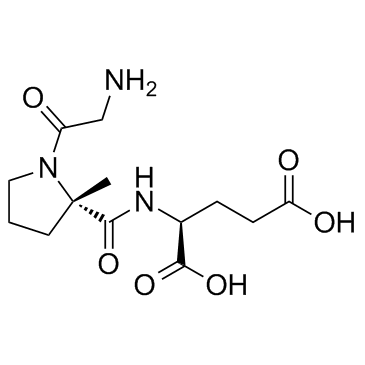853400-76-7
| Name | Trofinetide |
|---|---|
| Synonyms |
glycyl-2-methyl-L-prolyl-L-glutamic acid
L-Glutamic acid, glycyl-2-methyl-L-prolyl- UNII:Z2ME8F52QL UNII-Z2ME8F52QL Z2ME8F52QL H-Gly-PMe-Glu-OH Trofinetide |
| Description | Trofinetide, a synthetic analogue of the endogenous N-terminus tripeptide, Glycine-Proline-Glutamate (GPE), has been shown to be neuroprotective in animal models of brain injury. |
|---|---|
| Related Catalog | |
| In Vivo | Trofinetide (NNZ-2566) suppresses penetrating ballistic-like brain injury (PBBI) induced inflammatory cell infiltration at 3 days following PBBI as compare to vehicle treatment. Trofinetide treatment significantly reduces the elevation of IL-6 (79%), E-selectin (81%), IL-1β (76%) and TNF-α (72%) mRNA levels in the injured hemisphere at 12 h post-PBBI, with maximal inhibition occurring between 12 h and 24 h. Trofinetide treatment does not affect the PBBI-induced up-regulation of IL-6 expression at any time point, but does produce significant reductions in the injury-induced up-regulation of IL-1β, INF-γ, and TNF-α expression. Trofinetide treatment suppresses IL-1β expression in the injured brain hemisphere for up to 7 days post-PBBI[1]. The high doses of Trofinetide (NNZ-2566) (10 and 100 mg/kg bolus followed by continuous infusion) attenuate non-convulsive seizure (NCS) occurring beyond 2 h after permanent middle cerebral artery occlusion (pMCAo). All doses of Trofinetide completely suppress the delayed occurrence of NCS as compare with the vehicle-treated animals[2]. |
| Animal Admin | Three groups of eight rats are evaluated: vehicle/sham, vehicle/penetrating ballistic-like brain injury (PBBI), Trofinetide (NNZ-2566)/PBBI. A bolus injection of 10 mg/kg Trofinetide or 1 mL/kg saline (vehicle) is administered intravenously (IV) to each animal at 30 minutes post-PBBI surgery, immediately followed by a continuous IV infusion of Trofinetide at a rate of 3 mg/kg/h or an equal volume of vehicle for various durations (1 h, 4 h, or 12 h). Rats are subsequently euthanized and brain tissues are collected for processing at 1 h, 4 h, 12 h, 24 h, 3, and 7 days following the initiation of treatment[1]. |
| References |
| Density | 1.4±0.1 g/cm3 |
|---|---|
| Boiling Point | 655.4±55.0 °C at 760 mmHg |
| Molecular Formula | C13H21N3O6 |
| Molecular Weight | 315.322 |
| Flash Point | 350.2±31.5 °C |
| Exact Mass | 315.143036 |
| LogP | -2.22 |
| Vapour Pressure | 0.0±4.3 mmHg at 25°C |
| Index of Refraction | 1.558 |
| Storage condition | 2-8℃ |
